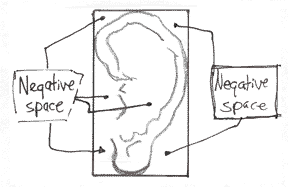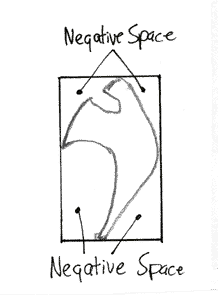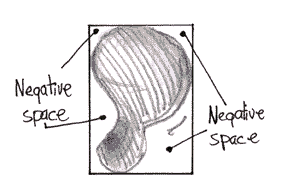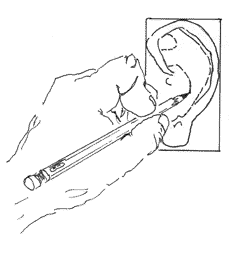![]()
Click for Ear's master link page
The Supply Store
Back to YouCanDraw .Com
A Quick Review of Negative Space and applying it to Drawing the Ear |
What's Negative space? It's the space, the nothing around and within the objects you're drawing. In this exercise you're going to get more practice looking for and recognizing negative space while drawing the ear and it's parts. If you've done the Pure and Modified Contour exercises this exercise will be a breeze for you. These different sections build on each other, so you're getting more practice than just drawing ears: you're solidifying skills that will allow you to draw anything.
So lets dive in.
Recall this illustration? (Just below.) It's from way back in Foundation Lesson 6 on Negative space. It's here to refresh your memory. In the illustration, the key and black string are "hard objects". Hard objects, or "positive forms" are real things, that is you can pick them up, hold them in your hand and you can name them. The spaces around the objects - and we tend to ignore these - are what we call "negative spaces".
Pick out the "Negative space"
In this first illustration, the "positive forms" are obvious enough - they're the keys and the black string. But now I want you to put your focus on the shapes surrounding the keys and string - this includes the shapes between the keys and string and the format. (The format is the rectangular frame that contains the picture.)
There's something subtle going on in this picture.
What's going on here? Just a picture of someone drawing keys and a string inside a rectangular format, right? Wrong! (Sorry, I set you up for that..) Of course if you said it was somebody drawing the spaces around the keys and string - I apologize - you were absolutely right.
The difference is subtle, but powerfully different. Put yourself in the body of the person doing the drawing. Now, how would it feel? Your attention is on those strange shapes created between the random lay of the string, the keys and the format. You're only indirectly observing the objects. The edges of these strange shapes you're drawing share their edges with the objects. These are drawable, definable shapes that are as real to the composition as the keys and string.
Making something of the nothing
The point of the exercises in Lesson 6 was to get you building an awareness of drawing things that aren't there, making something of the nothing. Like the holes in the Swiss cheese, or a middle of the donut, these "nothings" aren't anything physical you can put your hands on, but they do have a describable shape: that is you can draw them. They are "stand alone" shapes (albeit strange shapes) all by themselves and they help define indirectly the object you're drawing. In a drawing, they're as real as any other part of the composition. Think of a jigsaw puzzle: you can toss in your hand any piece of the puzzle regardless of what it has printed on it. This isn't how we normally approach drawing things in the world...
Here the Negative spaces are pointed out for you.
When you pay attention to negative space, when you acknowledge their shape as being as important to the composition as the actual object, well then you're in for an artistic breakthrough. In fact, you'll see if you just draw the negative space, you'll draw the positive form by default.
By drawing just the negative space, you learn to pay attention to the whole picture. |
Drawing the Ear as Negative Space
Approaching this as a negative space drawing.
These lessons are based on the idea that every one can learn to draw: we all have the capacity to see as an artist, we just have to step by step recover our innate ability to use the artistic mode of our brains. Like all the other exercise you've done, this one is designed to gently prod you into R-mode: your own real time, inborn artist-in-residence.
Here's a Helix. You've seen it in the two exercises before this, so I'm sure it's looking pretty familiar by now. (And that's kind of exciting: you're recognizing and feeling familiar with the anatomy. Great job!! Pat yourself on the back.) I've got it surrounded by a rectangular format. Before you scroll down the page to the answer, try and identify the negative spaces in this illustration:
Can you identify the Negative Spaces?
Look at the next picture. It'll make it pretty obvious where those negative spaces are....

The Negative Spaces around and in the helix/lobe.
Next we'll do this with the antihelix. But first I want you to pick up a pencil or pen and pick out right here on the screen the negative spaces surrounding and within this part of ear anatomy, the antihelix:
Point out the Negative spaces with a pen or pencil
Now that you've done that, take a look at the next illustration and see that you've correctly identified these areas.

Negative spaces around the
antihelix in
a rectangular format
Last but not least, pick out the negative spaces between the shadow area and it's format (this might appear a little trickier because you're dealing with shaded areas - still the principle is the same: concentrate on the general shape. Squint. This will blur detail and make the shape more recognizable):
Find the negative spaces here.
After going through all this, doesn't it seem you've come to realize the ear is made of some pretty simple shapes? Look at the next illustration and I'm sure you'll see you've correctly identified the non-object, negative spaces:

Negative spaces around the ear's shadow area.
We're going to draw the
helix again: this time by drawing nothing but the spaces
around it.
Step 1:
Draw yourself a format or download/print the formats for each part of the ear. It doesn't have to be perfect - just rectangular, taller than it is wide. You can reference or print the formats below if you like.(Note: recall the format is the shape, the frame around your drawing, within which you'll do your drawing. Any questions, review the illustrations in the Formats section of lesson 6.)
Format for "Shadow area" of ear
Step 2
Center your attention on the negative spaces. They may be within the object, between objects, or they'll exist between the object and the boundary of the format. (Refer to the picture if necessary.)

Imagine that the space between the helix and the format is another piece of the jigsaw puzzle - just like the blue water was a unique jigsaw puzzle piece against the orange sail in the jigsaw puzzle example in lesson 4. (In a jigsaw puzzle, the "not-object" negative spaces are as real as the object. Think of the negative spaces as being that substantial - like you could almost cut them out of a plywood plank and hold it them your hand.)
Imagine that the space is as much a real element of what is before your eyes as is the actual anatomy. Keep looking at it until you perceive the space meeting the helix in a shared edge - that the edge of the ear and the edge of the space are two different things but together they form a single edge.
Step 3
Draw the "negative spaces" around the helix.
Now begin drawing the helix but draw the spaces. Concentrate on the spaces as if they were real objects. Sometimes you need to stare at the spaces for a moment or two and the magically, your mind accepts them as real - if unnamable - forms.
Allow yourself to look through the forms - you want to arrive at a mental vantage point where you perceive the negative spaces as shapes every bit as real as the objects.
Step 4: Optional step
Just for fun, and if you want to really drive home the concept of negative space, you can do this: color in those spaces with a colored pencil or a marker like they're shown in the example. Coloring these in makes them more real, gives them more weight, convinces your mind of their realness.
Negative space colored blue
Color the negative spaces with a marker or pencil.
Step 5
Now, stare at one of the shapes. Keep looking at it. Gaze at it until you feel it to be real shape - as substantial as any object on the page. Gaze at it the way you looked at the vase-face, (lesson 2) in the earliest lessons. Remember how it shifted back and forth from vase to face? And when it "popped" into either the vase or the face, recall how it suddenly was one or the other? You're working for that same effect here.
Be patient, it may not happen instantly. It'll take L-mode a second to realize it's got no name or category for this thing - so it'll want to scan it's banks for some kind of association. Let it do what it has to. Eventually it'll get frustrated and allow R-mode to take over. And that's exactly what we want.
Step 6
In this last step, repeat steps 1 - 3, and step 5 (4 is optional) for the antihelix and the shadow area. Then take a break! You deserve it. If you're still hungry for more drawing today do the "One Last Negative Space" assignment. Otherwise, do this last assignment tomorrow or the next day when you're fresh. It'll tie the whole ear together for you!
One last negative space
assignment:
Pulling Negative Space together
Now that you've gone through drawing all the parts of the ear by themselves, you've got a pretty good foundation in how the ear is put together. That's great. Don't get discouraged thinking you're going to have to trudge through the same stuff with all the features - well actually you will - but you've got a firm and growing foundation in applying the basic skills of drawing, as seeing as an artist sees. That foundation will serve you and allow you to cruise right along in the coming assignments. In the mean time, you'll be building depth and breath with each exercise you do: you are on your way to becoming a caricature artist!
Part 1
To tie together negative space and ear anatomy, I want you to do one last set of drawings. You should by now have quite a number of helix, shadow, and antihelix drawings - all within a rectangular format, right?
Here's what I want you to do. Stack up all your helix drawings. One by one, draw the antihelix within the helix. It'll look something like this:

Draw the antihelix inside formatted helix drawings you've already done (the dotted line in this picture).
This time, by referencing the ear above, concentrate on how the antihelix fits inside the helix. Look at where the top of the "Y" contacts the the curve of the helix. As in the Modified Contour, judge the angle the antihelix intersects the curve of the helix. See how nicely it all fits together?
Now draw
Part 2
When you're finished, collect all the previous drawings you've done of just the antihelix. Following the same directions you did in part one, draw the shadow area within the antihelix. See how nicely they share edges? How nicely they fit together?
Draw the "shadow
area" inside
old antihelix drawings.
Part 3
Collect all the drawings you did in part 1. (Those are the Helix with the superimposed antihelix drawings: they've got 2/3's of the parts, right?) Now draw the shadow area within each of those drawings so when you're finished you'll have a whole gang of completed ears.
Remember to compare lines and
angles: compare
them to each other and compare them to
the
vertical and horizontal of the format
Do them one after another. Refer to the illustrations on the screen if you get stuck.
Part 4
I'll bet with each drawing, you're doing each one just a little faster. Fantastic. If not, you will be. In this last part, you'll be drawing a bunch of ears (all left ears).
Draw rectangular formats. (Inside them you'll be drawing full ears - ears with the helix and lobe, antihelix, and shadow area.) Draw the formats freehand. Draw them rough and rapid. Make the formats different sizes, 1 inch to 5 inches tall. Vary their width. Draw half a dozen of them. Now, within each format, draw an entire ear - do it form memory, but be aware of how the parts come together, how they share lines, how they fit. It's ok to reference the other pictures.
Yes, you can do them from memory! And they don't have to be perfect! And that's the whole idea of caricature: realism with distortion. This should be fun. Let your hair down and go to it. You can do it!
Part 5
Lastly, follow the steps of part 4 but draw the ear without a format, do them entirely freehand and do them from memory. Go!
Congratulations!
Go to the next section on applying the technique from "Vase/Face" to the ear. It's not nearly as long as these first three sections and it sets you up for a really fun exercise: cartooning the ear.
In this section, you'll be concentrating on doing both left and right ears. Up to the is point, all you've been drawing is left ears and ear parts.
Go to "Vase-face" drawing of the ears
Click for Ear's master link page
Kasbohm & Company's
YouCanDraw.com
© Copyright, All rights reserved 1997
e-mail: jeffkaz@YouCanDraw